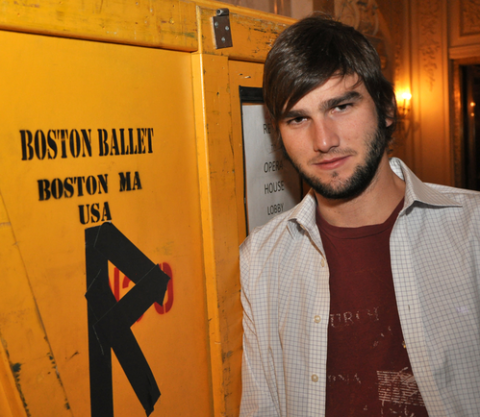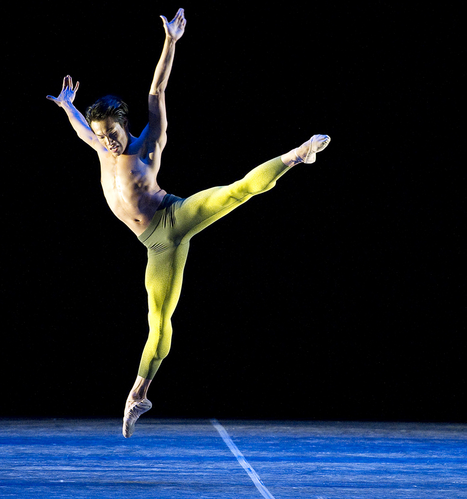At the Ballet with Alumnus Lucas Vidal '06

Lucas Vidal '06 takes time from his burgeoning film scoring career to compose for ballet.
Photo by Phil Farnsworth

Boston Ballet's John Lam in Yury Yanowsky's <em>Li3</em>
Photo by Gene Schiavone

Vidal and his cousin, principal dancer Yury Yanowsky, have been collaborating since Vidal's first year at Berklee.
Photo by Phil Farnsworth
In the dark theater, music boomed. "We're not ready!" a stagehand called out. A pause. Then: "We're ready whenever you're ready." The music started again, and three dancers—two men and a woman—took their places.
It was the Boston Ballet's first on-stage rehearsal for the eight-minute piece Li3 (Lithium), a world premiere choreographed by principal dancer Yuri Yanowsky. Even with a partial orchestra and the dancers in workout clothes, the powerful leaps were breathtaking.
The movies may be magic, but for film scorer Lucas Vidal '06, a composition alumnus and Yanowsky's cousin, there's something uniquely thrilling about professional ballet. Especially when it's his own music inspiring the dancers to move.
Ballet grew out of collaborations between the genre's master choreographers and composers. "There used to be [teams] like Balanchine and Stravinsky—they used to work together," Yanowsky said after the run-through. "[Choreographer] Petipa would go to Tchaikovsky and say 'I need eight more bars.'"
That's not the norm anymore, though. "I would say it's fairly rare to create a new work with a new composition," Boston Ballet PR/communications manager Mariel MacNaughton said in an email.
Vidal got his toes wet his first year at Berklee, when he and his cousin collaborated on a scene inspired by the German expressionist film Metropolis for the company's "Raw Dance" series of works created in about two weeks. They went on to collaborate on a piece for the Providence Ballet.
Still, Yanowsky started developing Li3 alone, listening to music by Ravel and Chopin. But those selections seemed a little. . . shop-worn. "Everybody has choreographed with this music," he said. He decided to ask Vidal if he had any completed scores on hand. "I know he's busy. He has a lot of movies," Yanowsky said. But Vidal—whose resume includes the documentary Make Believe; Vanishing on 7th Street, starring Hayden Christensen; and Cold Light of Day, starring Sigourney Weaver and Bruce Willis—well, leaped at the chance to create an entirely new composition.
The speed of the first partnership served the pair well for Li3, which came together in about six weeks. The process was a little more high-tech than Balanchine and Stravinsky's—though if Yanowsky had gotten the commission a few weeks earlier, they could have worked it out at the annual family vacation in Spain. "We actually connect on Skype," Yanowsky said, the one dancing, the other playing piano until they came to an agreement. For the choreographer, "this is the greatest thing. . . a give-and-take," he said.
While Vidal loves movies, "in ballet, you are completely free," he said. That said, Yanowsky did have certain ideas in mind—exploring concepts of femininity, masculinity, and neutrality. In terms of pace, "he wanted a very strong beginning," then a quiet portion, "then to finish very strong," Vidal said.
The art form also imposes certain demands. "It has to have some elements to help the dancer to dance," Vidal explained, describing them as "colors, or small 'hits' here and there." It helped that he started taking ballet classes in L.A. earlier this year. "For me, it's good to understand the technique," he said. "Dance is about the dancers and the way they move."
Yanowsky could see the impact of those classes. His cousin was beginning to understand fine points—for instance, when "this violin [line] needs to be longer because of this step," Yanowsky said, gesturing to indicate a dramatic arabesque.
Orchestrally, though both film scoring and ballet employ live musicians, "here they are in a pit so all the sonorities are completely different," Vidal said. "That's something I'm also learning."
And whereas film music gets recorded once and for all, "This piece. . . it's always going to change," Yanowsky said. "The music will evolve, the piece will evolve."
When the curtain went up on the October 23 gala, the critics took notice. "Principal Yuri Yanowsky's dramatic and athletic Li3 impressed," Keith Powers wrote in the October 25 Boston Herald. The "striking" collaboration also drew encouragement from Thomas Garvey in Hub Review: "The up-and-coming Mr. Vidal came up with an appealing score that sounded a bit like Philip Glass with romantic film music threaded through it."
"We'd love to continue these things because he is a very creative dancer," Vidal said of his cousin at the rehearsal. "I don't know if it's genetic—we click," Yanowsky continued.
Li3 ended with one of the men throwing the woman straight into the air and stepping away. The second man stepped forward to catch her. The moment showed, like its creators, the power of teamwork.
